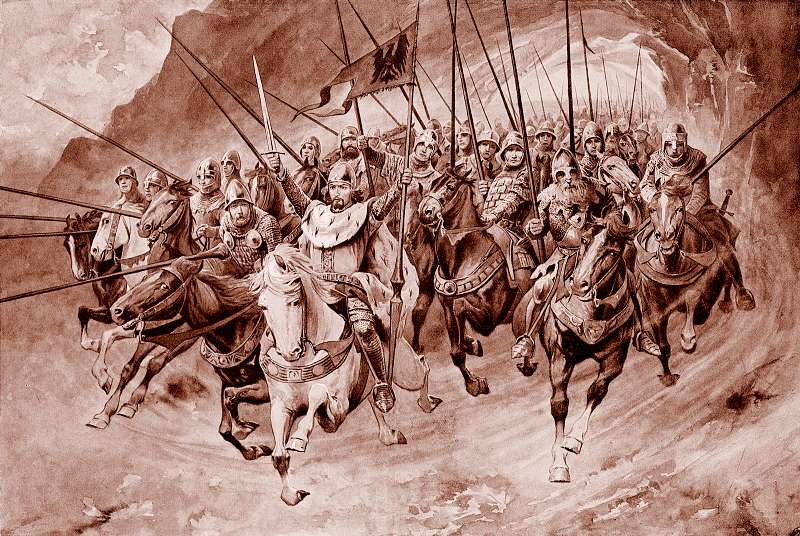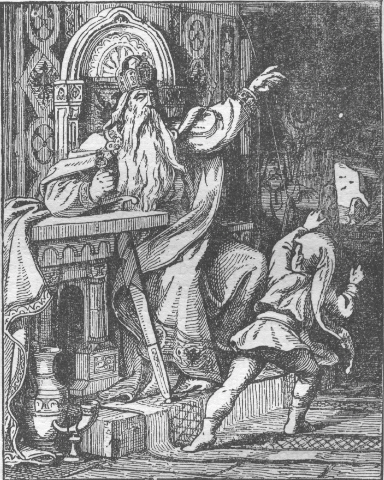|
Blaník
Blaník (Czech: ) is a mountain in the Czech Republic near Louňovice pod Blaníkem. The hill and surrounding area is a Protected areas of the Czech Republic, protected landscape area. The Blaník massif consists of two forested rocky hills, Velký Blaník ("Great Blaník"; 638 m) and Malý Blaník (Small Blaník"; 580 m). The mountain has played an important role in Czech national mythology since the Middle Ages (together with the mountains Říp and Radhošť); therefore, during the era of the Czech National Revival, a stone quarried from Blaník was symbolically placed in the foundations of the newly built National Theatre (Prague), National Theatre in Prague. Buildings In the 5th century BC, during the Hallstatt culture, Hallstatt period, a circular hillfort with two rows of massive stone walls was built at the top of Great Blaník; its remnants are still visible around the summit. Later, a fortress and probably a wooden castle were built there. At the top of Great Blan ... [...More Info...] [...Related Items...] OR: [Wikipedia] [Google] [Baidu] |
Louňovice Pod Blaníkem
Louňovice pod Blaníkem () is a market town in Benešov District in the Central Bohemian Region of the Czech Republic. It has about 700 inhabitants. Administrative division Louňovice pod Blaníkem consists of five municipal parts (in brackets population according to the 2021 census): *Louňovice pod Blaníkem (585) *Býkovice (38) *Mrkvová Lhota (16) *Rejkovice (5) *Světlá (10) Geography Louňovice pod Blaníkem is located about southeast of Benešov and southeast of Prague. It lies in the Vlašim Uplands. The highest point is the mountain of Blaník, Velký Blaník at above sea level, notable as the object of one of the most popular Blaník#Legend, national legends. The Blanice (Sázava), Blanice River flows through the municipal territory. The entire territory lies within the Blaník Protected Landscape Area. History The first written mention of Louňovice is from 1149, when there was founded a women's Premonstratensians, Premonstratensian monastery. In 1420, the monas ... [...More Info...] [...Related Items...] OR: [Wikipedia] [Google] [Baidu] |
Má Vlast
(), also known as ''My Fatherland'', is a set of six symphonic poems composed between 1874 and 1879 by the Czech composer Bedřich Smetana. The six pieces, conceived as individual works, are often presented and recorded as a single work in six movements. They premiered separately between 1875 and 1880. The complete set premiered on 5 November 1882 in Žofín Palace, Prague,Žofín Palace Official site of Žofín Palace, accessed 7 December 2016. under Adolf Čech. ''Má vlast'' combines the symphonic poem form, pioneered by , with the ... [...More Info...] [...Related Items...] OR: [Wikipedia] [Google] [Baidu] |
Kunštát
Kunštát (; ) is a town in Blansko District in the South Moravian Region of the Czech Republic. It has about 2,900 inhabitants. Administrative division Kunštát consists of six municipal parts (in brackets population according to the 2021 census): *Kunštát (1,903) *Hluboké u Kunštátu (61) *Rudka (215) *Sychotín (242) *Touboř (25) *Újezd (288) Geography Kunštát is located about northwest of Blansko and north of Brno. It lies in the Upper Svratka Highlands. The highest point is at above sea level. The Petrůvka stream flows through the town. History The first written mention of Kunštát is from 1279, when the owner of the estate and the builder of the castle was Kuna and the settlement was named after him. Lords of Kunštát held the estate until 1521. The most famous of the family was King George of Poděbrady, who was the owner of Kunštát manor from 1427 to 1464. In 1678, the manor was bought by the Counts of Lamberg. The Lambergs had the Kunštát Castle re ... [...More Info...] [...Related Items...] OR: [Wikipedia] [Google] [Baidu] |
Ancient Bohemian Legends
''Ancient Bohemian legends'' () is a book by Alois Jirásek written in 1894. It describes events from Czech Republic, Czech history based on folk literature and some historical facts. The model was based on Chronicle of Hájek, Cosmas of Prague, Cosmas Chronicle of Bohemia and Chronicle of Dalimil, other old Czech chronicles and many other sources were also used. It includes legends such as ''The Maidens' War, Maidens' War'', ''Libuše and Přemysl, the Ploughman, Přemysl'', ''Duke Krok, Krok's Daughters'', ''Lech, Czech and Rus, Bohemian Arrival'' and ''Golem of Prague''. The book has three parts: ''Ancient Bohemian Legends'', ''Legends of the Christian era'' and ''From ancient prophecies''. Ancient Bohemian Legends ''Forefather Čech'' According to myth, some Slavic peoples, Slavic people from an area between the Vistula River and Carpathian Mountains set off to the west in search of plentiful lands. They were led by Lech, Czech and Rus, Forefather Čech and his brother, ... [...More Info...] [...Related Items...] OR: [Wikipedia] [Google] [Baidu] |
Protected Areas Of The Czech Republic
There are several types of protected areas of the Czech Republic. The main form of landscape protection is delimitation of special protected areas. All the types of protected areas are determined by law. Special protected areas There are six types of special protected areas distinguished by their size and importance. The types of large-scale protected areas are national park and protected landscape area; the types of small-scale protected areas are national nature reserve, nature reserve, national nature monument, and nature monument. National park National park (, abbreviated as ''NP'') are defined as a large areas with a typical relief and geological structure and a predominant occurrence of natural or man-made ecosystems, unique and significant on a national or international scale in terms of ecology, science, education or awareness. They are established by the Czech Government. As of 2021, there were four national parks in the Czech Republic: Protected landscape area Landsc ... [...More Info...] [...Related Items...] OR: [Wikipedia] [Google] [Baidu] |
Wenceslaus I, Duke Of Bohemia
Wenceslaus I ( ; 907 – 28 September 935), Wenceslas I or ''Václav the Good'' was the Prince (''Knyaz, kníže'') of Duchy of Bohemia, Bohemia from 921 until his death, probably in 935. According to the legend, he was assassinated by his younger brother, Boleslaus I, Duke of Bohemia, Boleslaus the Cruel. His martyrdom and the popularity of several biographies gave rise to a reputation for heroic virtue that resulted in his sainthood. He was posthumously declared to be a king and patron saint of the Czech Republic, Czech state. He is the subject of the well-known "Good King Wenceslas", a carol for Saint Stephen's Day. Biography Wenceslaus was the son of Vratislaus I, Duke of Bohemia from the Přemyslid dynasty. His grandfather, Bořivoj I of Bohemia, and grandmother, Ludmila, had been converted by Cyril and Methodius to Eastern Orthodox Church, Byzantine Christianity in a still unified Christendom, before the East–West Schism, Great Schism. His mother, Drahomíra, was the d ... [...More Info...] [...Related Items...] OR: [Wikipedia] [Google] [Baidu] |
Bedřich Smetana
Bedřich Smetana ( ; ; 2 March 1824 – 12 May 1884) was a Czech composer who pioneered the development of a musical style that became closely identified with his people's aspirations to a cultural and political "revival". He has been regarded in his homeland as the father of Czech music. Internationally he is best known for his 1866 opera '' The Bartered Bride'' and for the symphonic cycle '' Má vlast'' ("My Fatherland"), which portrays the history, legends and landscape of the composer's native Bohemia. It contains the famous symphonic poem "Vltava", also popularly known by its German name "Die Moldau" (in English, "The Moldau"). Smetana was naturally gifted as a composer, and gave his first public performance at the age of six. After conventional schooling, he studied music under Josef Proksch in Prague. His first nationalistic music was written during the 1848 Prague uprising, in which he briefly participated. After failing to establish his career in Prague, he left fo ... [...More Info...] [...Related Items...] OR: [Wikipedia] [Google] [Baidu] |
King Asleep In Mountain
The king asleep in the mountain (D 1960.2 in Stith Thompson's Motif (folkloristics), motif-index) is a prominent folklore Trope (literature), trope found in many folktales and legends. Thompson termed it as the Kyffhäuser type. Some other designations are king in the mountain, king under the mountain, sleeping hero, or Bergentrückung ("mountain rapture"). Examples include the legends of King Arthur, Fionn mac Cumhaill, Charlemagne, Ogier the Dane, King David, Frederick Barbarossa at Kyffhäuser, Genghis Khan, Constantine XI Palaiologos, Prince Marko, Kraljević Marko, Sebastian of Portugal and King Matjaž. The Thompson motif entries A 571, "Cultural hero asleep in mountain", and E 502, "The Sleeping Army", are similar and can occur in the same tale. A related motif is the "Seven Sleepers" (D 1960.1, also known as the "Rip Van Winkle" motif), whose type tale is the Seven Sleepers of Ephesus (Aarne-Thompson classification system, AT tale type 766). General features King in ... [...More Info...] [...Related Items...] OR: [Wikipedia] [Google] [Baidu] |
Vlašim Uplands
Vlašim (; ) is a town in Benešov District in the Central Bohemian Region of the Czech Republic. It has about 11,000 inhabitants. Vlašim is known for the Vlašim Castle and its English park. Administrative division Vlašim consists of seven municipal parts (in brackets population according to the 2021 census): *Vlašim (9,990) *Bolina (408) *Domašín (618) *Hrazená Lhota (57) *Nesperská Lhota (80) *Polánka (28) *Znosim (103) Etymology The name is derived from the personal name Vlašim, meaning "Vlašim's (property)". Geography Vlašim is located about southeast of Benešov and southeast of Prague. It lies in the Vlašim Uplands. The highest point is at above sea level. The Blanice River flows through the town. Climate Vlašim's climate is classified as humid continental climate (Köppen: ''Cfb''; Trewartha: ''Dobk''). Among them, the annual average temperature is , the hottest month in August is , and the coldest month is in January. The annual precipitation is , o ... [...More Info...] [...Related Items...] OR: [Wikipedia] [Google] [Baidu] |
Let L-13
Let or LET may refer to: Sports * Let serve, when the served object in certain racket sports hits the net and lands in the correct service court, such as; ** Let (badminton) ** Let (pickleball) ** Let (tennis) * Ladies European Tour, the ladies professional golf tour of Europe Terminology * -let as an English diminutive suffix * Let expression, a name binding construct in computer programming languages * Let statement, a statement used in word problems requiring algebraic equations * Letting, a system of payment for the temporary use of something owned by someone else, also known as "rental" People, titles, characters * Licensed engineering technologist * Let, a fictional character from the anime series '' Rave Master'' Places, locations * County Leitrim, Ireland, Chapman code LET * Let, West Virginia * Leț, a village in Boroșneu Mare Commune, Covasna County, Romania * Alfredo Vásquez Cobo International Airport (IATA code LET), Leticia, Colombia * Lei Tung station (sta ... [...More Info...] [...Related Items...] OR: [Wikipedia] [Google] [Baidu] |
Sandstone
Sandstone is a Clastic rock#Sedimentary clastic rocks, clastic sedimentary rock composed mainly of grain size, sand-sized (0.0625 to 2 mm) silicate mineral, silicate grains, Cementation (geology), cemented together by another mineral. Sandstones comprise about 20–25% of all sedimentary rocks. Most sandstone is composed of quartz or feldspar, because they are the most resistant minerals to the weathering processes at the Earth's surface. Like uncemented sand, sandstone may be imparted any color by impurities within the minerals, but the most common colors are tan, brown, yellow, red, grey, pink, white, and black. Because sandstone beds can form highly visible cliffs and other topography, topographic features, certain colors of sandstone have become strongly identified with certain regions, such as the red rock deserts of Arches National Park and other areas of the Southwestern United States, American Southwest. Rock formations composed of sandstone usually allow the p ... [...More Info...] [...Related Items...] OR: [Wikipedia] [Google] [Baidu] |






